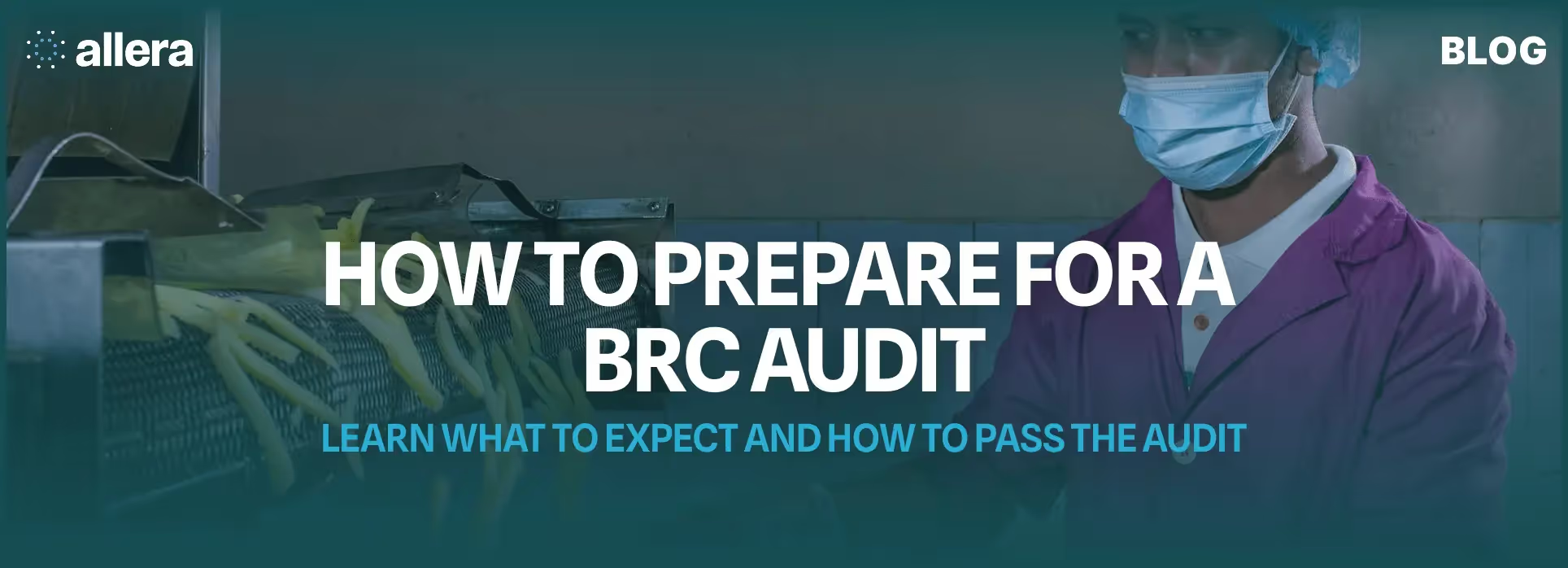

BRC Audit Preparation: Checklist and Actions

BRC Audit Key Takeaways
- Start Early: Begin preparing at least six months in advance to identify and address gaps.
- Train Your Team: Ensure all staff are well-versed in food safety protocols and audit expectations.
- Mock Audits Are Essential: Conduct trial audits to build confidence and refine processes.
- Documentation Is Key: Keep all records organized and easily accessible for auditors.
- Focus on Details: Small issues like equipment calibration and facility cleanliness can impact your score.
TL;DR: BRC audits fail because of poor preparation, not poor practices. Start six months early, focus on documentation and training first, and use this systematic approach to avoid the mistakes that fail 34% of manufacturers.
Why BRC Certification Matters
The BRCGS certification is extremely important in today's food manufacturing landscape. Major reasons for this include:
- Meet standards required by major retailers such as Walmart and Whole Foods.
- Build trust with regulators, customers, and partners.
- Reduce food safety errors, improve efficiency, and open doors to new markets.
BRCGS Food Safety is a widely adopted global standard, now on Issue 9 and used by tens of thousands of sites in more than a hundred countries. Buyers request it because it signals mature systems, predictable quality, and strong governance.
BRC Audit Explained: Key Requirements, Process, and Grading
The BRCGS Global Standard for Food Safety evaluates your entire food safety management system—from leadership and culture to food traceability, HACCP, hygiene, supplier management, and change control. Most retailers look for strong grades, typically B or better, as a condition to continue doing business.
Audit grading at a glance: BRCGS grades range from AA (highest) to D, with a “+” appended for unannounced audits (e.g., AA+). Grades are driven by the number and severity of non-conformities identified during the audit.
What auditors focus on during inspections:
- Food safety culture and leadership involvement
- Compliance documentation and document control
- Staff training (especially allergens and HACCP responsibilities)
- Hygiene, sanitation, pest control, and facility maintenance
- Supplier approval, ingredient authenticity, and vulnerability assessments
BRC Audit Preparation Checklist (6 Months to Audit Day)
Preparing for a BRC audit doesn’t have to be overwhelming. Tackle it systematically so you can demonstrate control, consistency, and continuous improvement.
6 Months Before
Form a cross-functional preparation team that includes QA/FSQA, production, maintenance, sanitation, warehousing, and purchasing. Assign clear owners for documentation, equipment checks, storage conditions, and training updates so nothing falls through the cracks.
Run an internal pre-audit against the BRCGS Issue 9 clauses and your scope. It’s better to discover gaps now than on audit day. Prioritize high-risk and legally sensitive areas first—think allergen control, recall/traceability, foreign-material prevention, and pest control. Confirm which products, processes, and sites are in scope, and align on applicable food sector categories with your certification body.
People & Roles
- Appoint a clearly identified BRC/QA lead as the single point of contact.
- Ensure line leaders can answer auditor questions about their area (sanitation steps, hold/release, metal detection checks, allergen changeovers).
- Designate backups for critical roles to avoid single-point failures.
- Set expectations for professional conduct during interviews: answer directly, cite the procedure, and show the record.
Programs & Documentation
- Map your document hierarchy (policies → SOPs → work instructions → forms).
- Refresh prerequisite programs: GMPs, sanitation, pest, allergen control, calibration, supplier approval, glass/brittle plastic.
- Align your HACCP plan to current products, processes, and hazards; re-validate critical limits where needed.
- Establish version control and a master index so you can retrieve any record within minutes.
3 Months Before
Deliver targeted training on GMPs, allergens, HACCP basics, foreign-material controls, and recall procedures. Don’t just instruct—assess comprehension. Ask practical questions an auditor might ask: “What do you do if contamination occurs?” “How do you verify allergen changeovers?” “Where is this SOP and how do you record compliance?”
Conduct at least one full mock audit. Include a timed traceability challenge from finished goods back to every lot of every component (and forward, if needed). Target four hours or less. Mirror real conditions: conduct interviews on the floor, perform document pulls, and verify records on demand.
Update HACCP/HARPC where risks, products, or processes have changed. Validate controls with recognized guidance and ensure monitoring and verification frequencies reflect risk. Confirm that deviation handling and corrective action steps are explicit and practiced.
Practice & Stress-Testing
- Simulate unannounced conditions: housekeeping at shift end, mid-run line checks, busy changeovers.
- Stress-test hold & release, deviation handling, and recall workflows.
- Verify supplier approval packets: specifications, COAs, food fraud/vulnerability assessments, and ongoing performance reviews.
- Run a label control drill to prove that artwork changes, allergen declarations, and rework use are controlled.
Documentation Records Readiness
- Ensure you have at least 90 days of clean, complete records: HACCP checks, CCP monitoring, sanitation verification, calibration, pest trend logs, training sign-offs, and corrective actions.
- Spot-check that each record ties back to a current SOP and that employees sign and date correctly.
- Trend your results so you can discuss improvement, not just compliance.
If you're having trouble with documentation, we recommend you check out Allera's documentation control. You can covert ALL your forms to digital in 30 days or less (yes, seriously), which comes in pretty handy if you're less than 90 days away from your next BRC audit!
Final Month
Centralize logs, SOPs, and records in a searchable system. A clean master index and tight version control make retrieval fast and reduce audit-room stress.
Assign a “runner” to fetch records and an “owner” to speak to each program.
Calibrate thermometers, scales, metal detectors, magnets, and check weighers. Repair cracked floors, peeling paint, missing light covers, and door sweeps. Small defects add up. Confirm chemical inventories are approved, labeled, and segregated. Inspect employee facilities, waste areas, dock doors, and external grounds.
Use routine ATP or micro swabs, visual inspections, and allergen verification as appropriate to your risk profile. Define performance criteria (visual, ATP, micro, chemical residues) and keep the trend data—auditors value evidence of control over time.
Audit Kit & Room
- Dedicated audit room with Wi-Fi, power, and visitor PPE
- Document binder or digital portal with quick links to policies, HACCP, training, calibration, pest, sanitation, CAPA logs, and management review minutes
- Label samples and packaging specs for quick reference
- Contact list for SMEs who can step in to answer process-specific questions
- Agenda for the day and a responsibility matrix so the team knows who does what
Final Week
Walk the facility daily to resolve lingering issues. Re-check glass and brittle plastics, tool accountability, compressed air filtration, and allergen segregation. Ensure every chemical is labeled and on the approved list. Rehearse brief, confident responses with supervisors and operators. Print the agenda, roles, and document index for quick hand-offs. Confirm visitor sign-in and escort procedures, hair and beard restraints, and traffic flows.
BRC Audit Day: What Auditors Look For
The day starts with an opening meeting, followed by document review, interviews, and an extensive facility tour. Expect real-time questions and requests for records to confirm that written procedures match practice.
Opening Meeting
Confirm scope, product categories, and audit program (announced vs. unannounced). Share a concise overview of your process flow and site map. Clarify how you control changeovers, rework, foreign-material risks, and vulnerable points.
Plant Walkthrough
Auditors observe GMPs in action: personnel hygiene, traffic flows, allergen changeovers, sanitation tools, foreign-material controls, preventive maintenance, and housekeeping. They look for consistency—do floor practices reflect what’s on paper?
Traceability & Verification
Be ready to pull complete traceability records (ingredients → WIP → finished goods → distribution) and verification evidence (calibrations, CCP checks, metal detection tests, cleaning verification, deviations and CAPAs). If a gap appears, acknowledge it, state the immediate correction, and outline your corrective action plan. For most findings, you’ll submit documented corrective actions within a defined window.
Post-BRC Audit Actions: Corrective Plans and Continuous Compliance
After the closing meeting, prioritize non-conformities by risk. Use root-cause analysis (e.g., 5 Whys, fishbone) so you fix the system, not just the symptom. Assign owners, due dates, and verification steps.
Building Effective CAPAs
- Containment: Quarantine affected product, add interim checks, or retrain as a short-term fix.
- Correction: Update the SOP or form; adjust monitoring frequency; repair or replace equipment.
- Verification: Prove the fix worked with new records, follow-up audits, or test results.
- Prevention: Address systemic risks (staffing, scheduling, equipment design, supplier controls, training program gaps).
Keep the System Alive
Carry momentum into management reviews, internal audits, and KPI dashboards. Track training completion, CCP performance, sanitation findings, pest trends, foreign-material incidents, and customer complaints. Schedule periodic program re-validations and mock recalls so readiness becomes routine rather than a scramble.
Common BRC Audit Mistakes (and How to Avoid Them)
- Missing Training Records: Every employee—including temps—needs documented, role-specific training that is current and signed.
- Incomplete Traceability: Practice full one-up/one-down traceability and include rework lots; verify labels and COAs match.
- Weak Allergen Controls: Inadequate segregation, poorly executed changeovers, unlabeled rework, or unverified cleaning.
- Poor Housekeeping: Residue, damaged surfaces, and clutter signal weak controls; daily clean-as-you-go reduces findings.
- Uncontrolled Documents: Out-of-date SOPs or unlabeled forms undermine credibility—tighten version control.
- Calibration Gaps: Missed or undocumented calibrations on thermometers, scales, detection devices, or check weighers.
How Digital Tools Improve BRC Audit Compliance and Documentation
Moving beyond paper reduces errors and makes you audit-ready every day:
- Centralized records with search and role-based access so evidence is at your fingertips
- Automated schedules for sanitation, calibrations, internal audits, changeovers, and training
- Real-time alerts for missed checks or out-of-tolerance readings
- CAPA workflows with evidence attachments, due-date tracking, and sign-offs
- Dashboards and trend charts for management review and continuous improvement
Digitization supports the BRCGS emphasis on robust management systems, objective evidence, and rapid retrieval. It also improves cross-functional visibility, which strengthens culture and reduces surprises.
Get an in-depth understanding of how digital tools help you stay BRC audit ready in our recent BRC audit software guide.
Final Thoughts
Preparing for a BRC audit isn’t just about passing once—it’s about building a durable culture of food safety and compliance. Start early, involve your team at every stage, and work a systematic plan that covers documentation, training, and operational detail. With the right preparation, you’ll not only achieve certification but also boost efficiency, strengthen brand trust, and expand market access.
If BRC Audits are causing lots of trouble for your team, consider Allera's Doc Control. You can centralize training logs, calibration records, HACCP updates, supplier approvals, and audit evidence in one secure, searchable hub. Stay audit-ready year-round and eliminate last-minute stress.
FAQs
How long does a BRCGS audit take?
Audit duration depends on the scope, site size, risk level, and product categories. A typical food manufacturing facility audit lasts 2–3 days, but certification bodies determine the exact length during audit planning.
Where can I learn more about BRCGS audits?
You can review the official BRCGS Food Safety Standard Issue 9 and audit protocol on the BRCGS website. For preparation, many facilities also invest in HACCP training, allergen management courses, and food safety workshops to build internal team capability.
What grade do most retailers expect on a BRCGS audit?
Expectations vary by customer, but many retailers require a minimum grade of B to approve a supplier. High-performing sites aim for A or AA grades, with A+ or AA+ reserved for unannounced audits. These higher scores signal stronger consistency and compliance.
How long should a facility keep records before the first BRCGS audit?
You should maintain at least 90 days of complete and consistent records before your first audit. This recordkeeping allows you to demonstrate control, identify trends, and show auditors that your food safety management system is functioning effectively.
Is BRCGS the same as BRC?
Yes. The British Retail Consortium (BRC) rebranded to BRCGS (Brand Reputation through Compliance Global Standards). The BRCGS Food Safety Standard, now on Issue 9, is one of the most widely recognized global certification programs for food safety and quality.




.avif)


.avif)
.avif)

